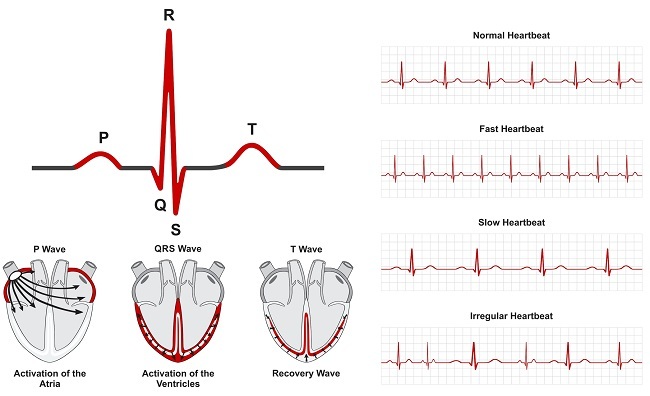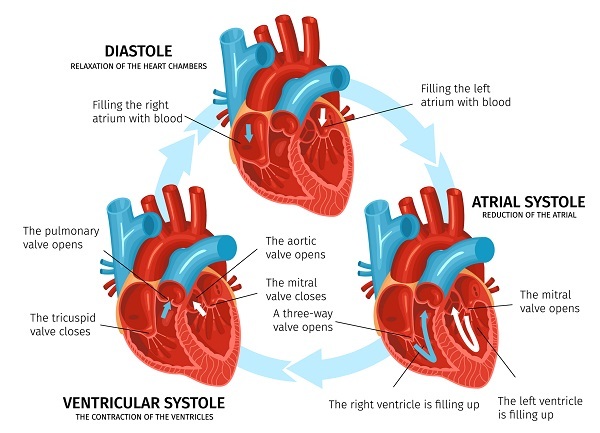
 Data Structure
Data Structure Networking
Networking RDBMS
RDBMS Operating System
Operating System Java
Java MS Excel
MS Excel iOS
iOS HTML
HTML CSS
CSS Android
Android Python
Python C Programming
C Programming C++
C++ C#
C# MongoDB
MongoDB MySQL
MySQL Javascript
Javascript PHP
PHPPhysics
Chemistry
Biology
Mathematics
English
Economics
Psychology
Social Studies
Fashion Studies
Legal Studies
- Selected Reading
- UPSC IAS Exams Notes
- Developer's Best Practices
- Questions and Answers
- Effective Resume Writing
- HR Interview Questions
- Computer Glossary
- Who is Who
Regulation of Cardiac Activity
Introduction
The heart of every living organism is made of muscles that are operating to pump gallons of blood. This is an involuntary muscle that starts when the offspring is present inside the womb. It never stops until the person passes away for some reason. The function of pumping blood is the most important activity in the study of cardiology.
This process is governed by several nerves in order to regulate nodal tissues. These tissues are known as sinoatrial node and atrioventricular node. They provide chemicals, hormones and various ions that help the heart increase or decrease its activities.
Cardiac Cycle

Figure 1: Electrocardiogram during Cardiac Cycle
The cardiac cycle helps the heart to pump a lot of blood into the body just to execute several chores in a day. There is a system of pumping the blood into the body, this system acts like a cycle where the blood goes in a loop. In this case, the upper chambers in the heart are known as atria and it receives blood from various organs. The chambers then contract to let the blood into ventricles, the lower chambers, from where it is then taken to different organs of the body. This is the way the cardiac cycle is covered by a heart apart from the other activities.
This cycle is supervised and regulated by some tissues that form a node. It is called the nodal tissues that have two significant classifications. One of them is classified as sinoatrial nodal tissue while the second is called atrioventricular nodal tissue. They are ancillary tissues that branches out of the autonomic nervous system.
Both of these tissues regulate in a pattern when the heart remains healthy. These two tissues come to increase or decrease the cyclic activities of the heart when they are subject to a few situations. The number of cycles that must occur in a healthy heart is 72 times in a minute.
Autonomic Regulation
The autonomic regulation of the heart is a very prominent activity for a muscle that beats until death. This regulation is maintained by the parasympathetic nervous system which is a part of the autonomic nervous system (ANS). This entire part of ANS is regulated by the medulla oblongata which is present in the brain of a human being.
The ANS has two nerves that work by contradicting either one of them. When the sympathetic nerves are stimulated for some reason they are able to keep contracting the atrial and ventricular muscles. When the nerves are very agitated the output of this cardiac cycle increases along with the beating of the heart. This is a time when the person is running laps or lifting weights in order to maintain a healthy routine.
There is a second instance when the heart starts to beat faster, it is the time when a person undergoes a stressful situation. One such example is the fear of riding a giant roller coaster, this puts down a negative effect on the heart. The sympathetic nerves get stimulation when the person laughs a lot or shares an intimate moment with their partner. This is a stress that gives a positive effect on the body of a human being.
The stimulation of parasympathetic nerves calms down the heartbeat to a normal level. In this matter, the contraction on the atrial and ventricle subsides in order to let the heart relax. Therefore, several cardiac activities slow down to a minimal level.
Chemical Regulation

Figure 2: Representation of Diastole and Systole
The heart beats 72 times in its normal condition by following the cardiac cycle. This is the reason why the heart needs some kind of chemicals, ions and hormones to execute these activities. The regulation of chemicals is very important due to the autonomic regulation of nervous tissues. This is the reason why the heart of a human being takes several hormones like epinephrine and thyroxine. They are necessary in order to increase the rate of a beating heart. In this case, the hormones also aid to assist the heart in contracting the ventricles and atrial. The regulation of heart by hormones is very similar to the way it is done by the autonomic regulation.
There is a very unique trait that is going to influence the rate of heartbeat. It is the gender of a human being that plays an influential role in increasing or decreasing the heartbeat.
Facts about Cardiac Activity
The facts about the cardiac activity are as follows-
The heart of a person is equal to the size of a fist clenched by a grown-up.
The heart beats 115,000 times in a day if they are healthy.
The cardiac conduction of a heart is like an electrical system that beats according to the rhythm.
The heart pumps 2000 gallons of blood in a single day.
Conclusion
In this tutorial, a learner can go through the two activities that cover cardiac cycles. The learners can go through the facts to understand the overall concept. There are diagrams that are here to provide better assistance to all the learners.
FAQs
Q1. What is the amount of time a heart beats for a minute?
Ans. The amount of time a heart beats for a minute is 72 only if it is healthy. When the blood pressure is low they reduce the rate of beating and the opposite happens when the BP is high.
Q2. What activities stimulate the sympathetic nerves?
Ans. The activities that stimulate the sympathetic nerve are physical exercise and sexual arousal.

